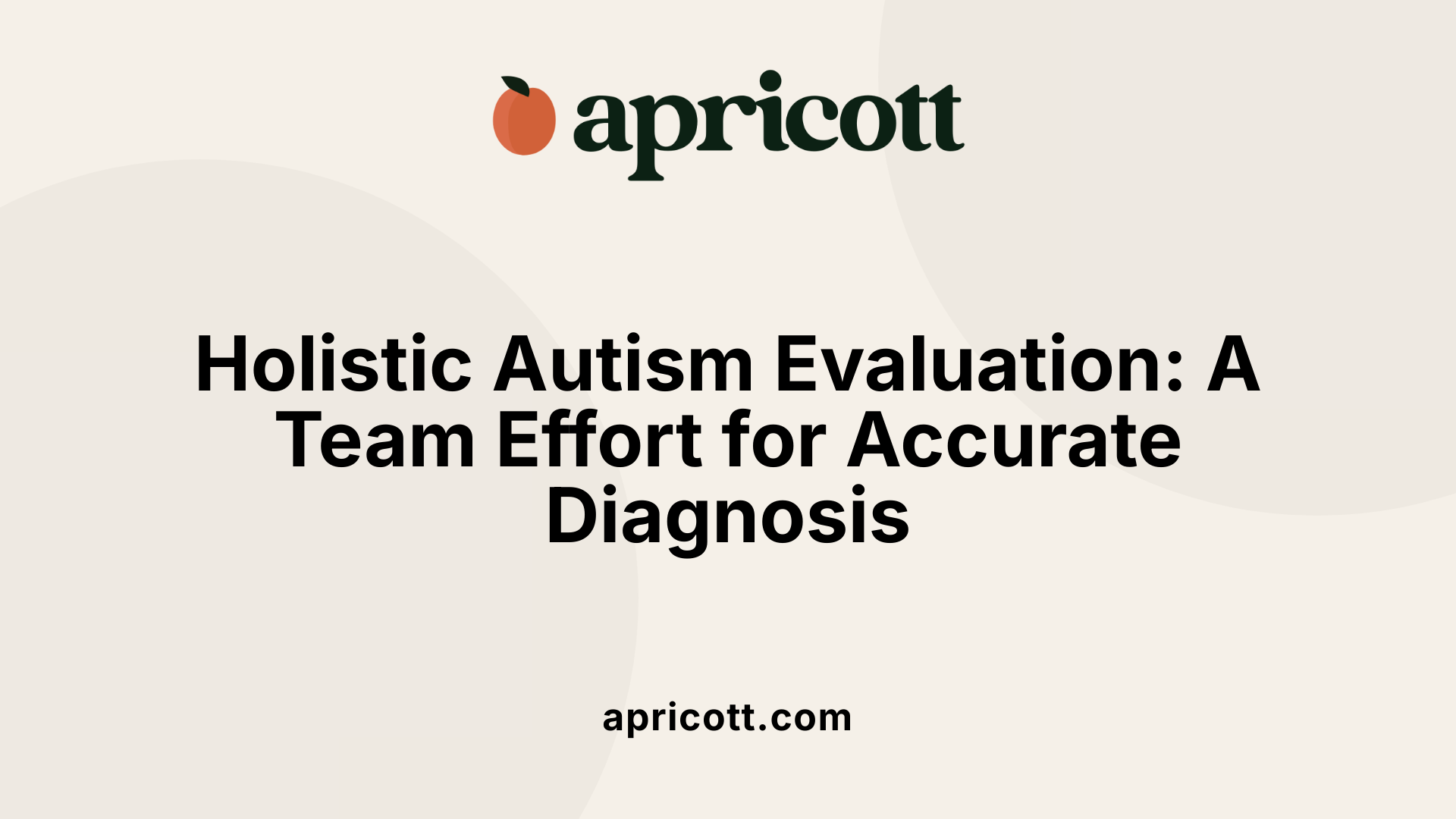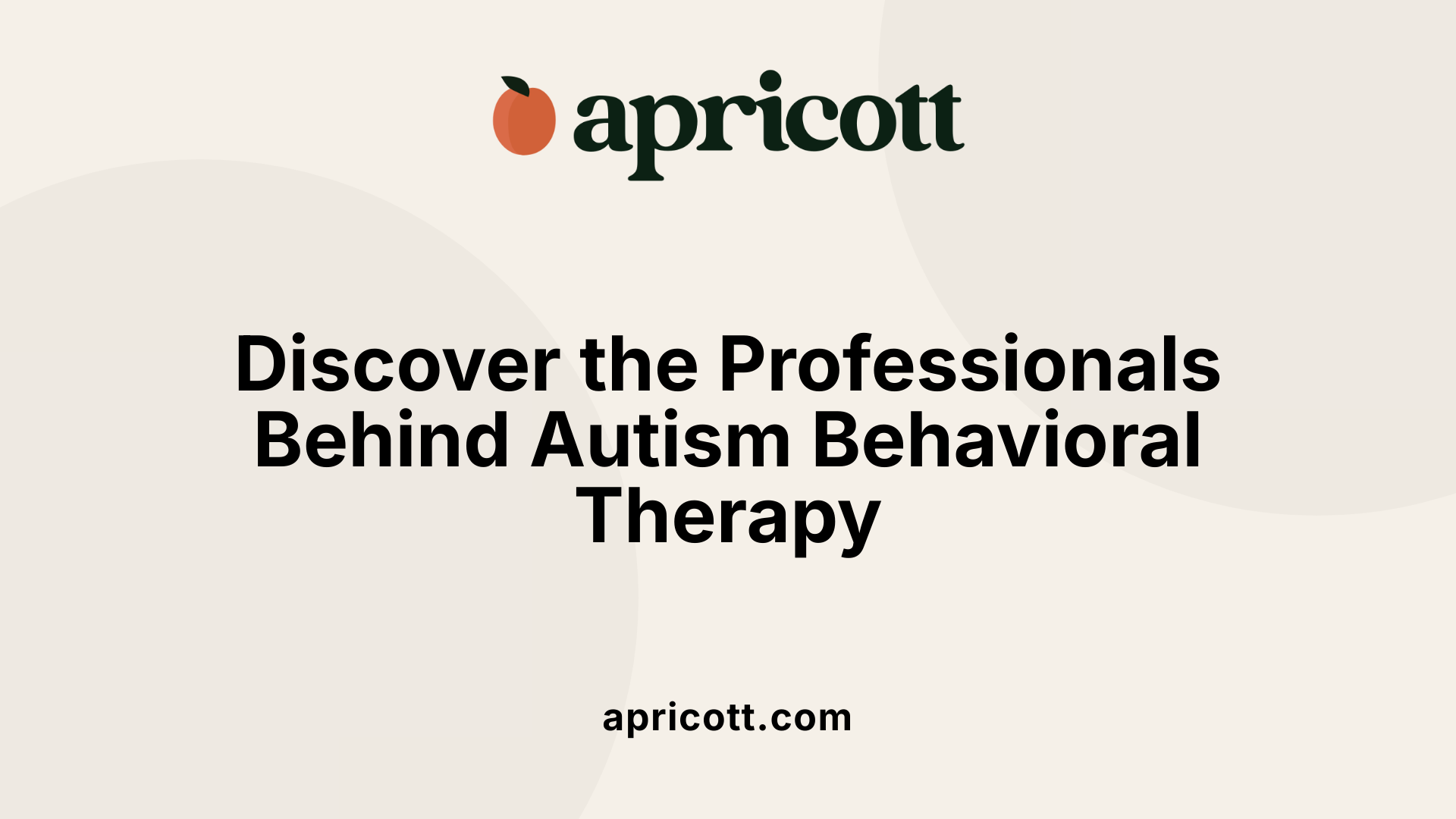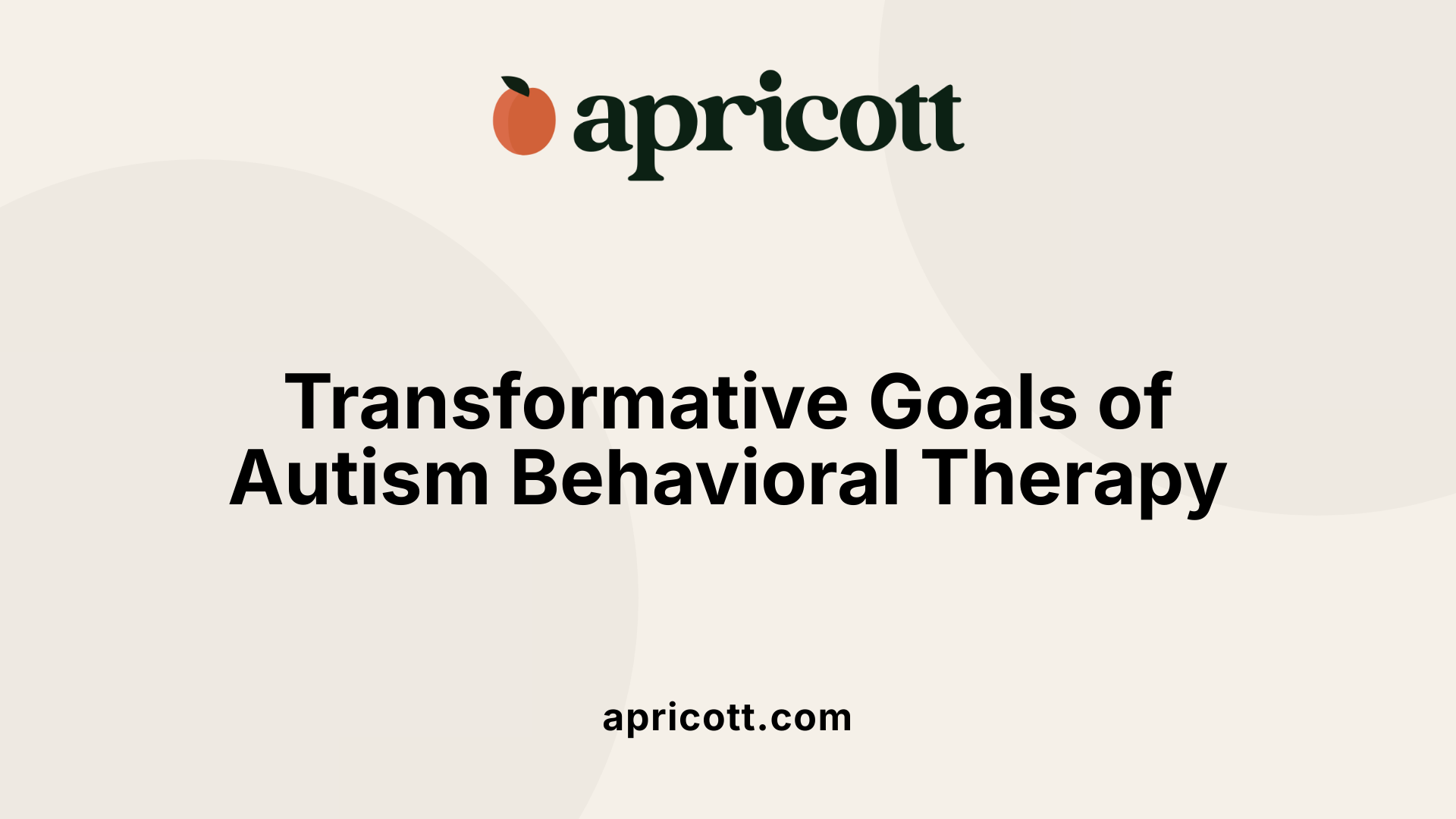Understanding Autism Evaluation
Autism Spectrum Disorder (ASD) is a complex developmental condition identified through a thorough evaluation process that involves multidisciplinary expertise and standardized tools. Early and accurate diagnosis is crucial for guiding effective intervention strategies tailored to individual needs. This article provides an in-depth overview of autism evaluation procedures, the role of behavioral therapies, and the spectrum of treatment options available to support individuals with ASD.
The Autism Evaluation Process: Foundations and Tools
Screening tools for autism
The evaluation for autism begins with screening tools designed for early detection during routine pediatric visits. The Modified Checklist for Autism in Toddlers (M-CHAT) is commonly used at 9, 18, and 24 to 30 months to identify children who may be at risk. These level 1 screenings are broad and applied to all children, while level 2 screenings help differentiate autism from other developmental disorders if concerns are raised.
Formal diagnostic assessments
When initial screenings indicate potential autism, formal diagnostic assessments follow. These include direct observation and interviews using tools such as the Autism Diagnostic Observation Schedule (ADOS-2) and the Autism Diagnostic Interview-Revised (ADI-R). Other assessment instruments that may be used are the Childhood Autism Rating Scales (CARS), Screening Tool for Autism in Toddlers (STAT), and the Tele-ADOS for telehealth evaluations. Language and cognitive assessments, such as the Peabody Picture Vocabulary Test or the Clinical Evaluation of Language Fundamentals, complement the autism-specific tools to comprehensively characterize an individual’s strengths and challenges.
Multidisciplinary team involvement
A thorough autism evaluation typically involves a multidisciplinary team of specialists. This team may include psychologists, developmental pediatricians, speech and language pathologists, board certified behavior analysts, neurologists, and licensed clinical social workers. They collectively review medical and developmental history, gather parental and caregiver input, and conduct observational assessments. Team evaluations often last two to four hours and are especially useful for complex cases or very young children, ensuring a full, nuanced understanding of the child's behaviors and needs.
Diagnostic criteria from DSM-5 and ICD-11
Diagnosis relies on established criteria from the DSM-5 and ICD-11 manuals. Both highlight core characteristics of autism spectrum disorder: deficits in social communication and interaction, restricted and repetitive behaviors, early onset symptoms, and sensory differences. The DSM-5 also requires evidence of impairment in functioning and considers exclusion of intellectual disability as the primary cause for observed behaviors. The use of these manuals ensures standardization and alignment with national and international guidelines.
How is autism evaluated and diagnosed?
Autism evaluation begins with initial screening tools like M-CHAT in early childhood. If concerns are present, a multidisciplinary team performs comprehensive assessments using standardized tools such as ADOS-2 and ADI-R. Diagnosis is confirmed by comparing findings against DSM-5 or ICD-11 criteria, with input from various sources and clinical judgment playing an essential role. This thorough process ensures accurate identification to guide effective support and intervention.
Early Screening and Importance of Timely Diagnosis

Levels and Timing of Autism Screening
Autism screening is a multi-level process starting with Level 1 screenings during routine well-child visits at 9, 18, and 24 or 30 months. These screenings are designed to identify developmental concerns in all children. If risks are flagged, Level 2 screening is used to differentiate autism from other developmental disorders. Tools like the Modified Checklist for Autism in Toddlers (M-CHAT) and its follow-ups are commonly employed by primary care providers for early detection.
Role of Primary Care Providers
Primary care providers play a crucial role in autism screening by conducting standardized assessments during scheduled visits and referring children for comprehensive evaluations when signs of ASD are detected. They also provide guidance to families about further diagnostic evaluations and intervention resources, ensuring timely access to care. Their vigilance is vital since some developmental issues may be subtle and easily missed without routine screening.
Benefits of Early Intervention
Early diagnosis opens the door to intervention programs available from birth to 36 months, which target communication, social, and behavioral skills during a period of heightened brain plasticity. Timely interventions have been shown to improve long-term outcomes for children with autism by enhancing development and reducing symptom severity. Early support services can include behavioral therapies such as Applied Behavior Analysis (ABA), speech-language therapy, and social skills development, helping children reach their full potential.
Multidisciplinary and Individualized Evaluation Approach

Who conducts autism evaluations?
Autism evaluations are typically conducted by a multidisciplinary team. This team includes psychologists, developmental pediatricians, speech and language pathologists, neurologists, board certified behavior analysts (BCBAs), psychiatrists, licensed professional counselors, and social workers. Their collaboration ensures a holistic understanding of each individual's unique needs.
Team-based assessments
The evaluation process involves comprehensive assessment sessions often lasting two to four hours. Teams conduct direct observations and standardized tests such as the Autism Diagnostic Observation Schedule, Second Edition (ADOS-2) and the Autism Diagnostic Interview-Revised (ADI-R). This collaborative approach helps address the complex and varied presentations of autism spectrum disorder (ASD).
Information gathering from multiple sources
Information is gathered from various channels, including detailed medical and developmental history reviews, behavioral observations, and parental or caregiver interviews. Input from educational and social contexts can also be essential, ensuring a full picture of the person’s abilities and challenges.
Use of behavioral and language assessments
Behavioral assessments capture social communication, repetitive behaviors, and related features, while language evaluations, through tools like the Peabody Picture Vocabulary Test and the Clinical Evaluation of Language Fundamentals, characterize speech and language abilities. These combined assessments are vital for diagnosing ASD and shaping individualized treatment plans.
This multidisciplinary and individualized evaluation approach is foundational to accurate autism diagnosis, guiding tailored intervention and support.
Core Diagnostic Criteria and Autism Characteristics
What clinical features define autism diagnosis?
Autism Spectrum Disorder (ASD) diagnosis hinges on recognized clinical features primarily detailed in two major diagnostic manuals: the DSM-5 and the ICD-11. Both stress the importance of identifying persistent challenges in social communication and interaction alongside restricted, repetitive behaviors and interests. Sensory processing differences are also frequently observed as part of the autistic profile.
The DSM-5 criteria specify that symptoms must manifest early in development, although they may not become fully apparent until social demands exceed capacities. These symptoms must produce significant functional impairment and cannot be better accounted for by intellectual disability alone. Similarly, the ICD-11 outlines requirements for early symptom onset and significant impairment across multiple life domains.
This detailed focus on the pattern of social, communicative, and behavioral symptoms helps clinicians distinguish ASD from other developmental disorders. Unlike other conditions, autism features a unique combination of social communication deficits coupled with repetitive behaviors and sensory sensitivities, which are not attributable solely to cognitive delays.
Understanding these core features ensures accurate diagnosis and guides tailored interventions essential for supporting individuals on the spectrum.
Behavioral Therapy for Autism: An Evidence-Based Approach
What is behavioral therapy for autism?
Behavioral therapy for autism primarily involves Applied Behavior Analysis (ABA), a highly evidence-based and systematic approach. ABA focuses on improving social, communication, and learning skills by employing structured methods such as positive reinforcement and consistent data collection. This helps promote beneficial behaviors while reducing challenging ones.
What are types of ABA interventions?
ABA includes various specialized teaching techniques, notably:
- Discrete Trial Training (DTT): Structured teaching method using short, repeated trials.
- Pivotal Response Training (PRT): Focuses on pivotal skills like communication initiation in natural settings to encourage generalization.
- Early Intensive Behavioral Intervention (EIBI): An intensive program typically used with young children to promote early skill development.
What are the principles of behavioral therapy?
This therapy is grounded in principles such as:
- Positive reinforcement to encourage desired behaviors.
- Prompting and shaping to guide learning.
- Ongoing data collection to monitor progress and adapt interventions.
- Individualized treatment plans tailored to each person's strengths and needs.
What is the role of behavior analysts and therapists?
Behavioral therapy for autism is delivered by trained professionals such as Board Certified Behavior Analysts (BCBAs) and therapists. They design, implement, and supervise interventions, often collaborating closely with families to provide parent training, ensuring that skills are practiced and reinforced at home. Their goal is to foster greater independence and enhance quality of life by developing functional skills.
Who Provides Behavioral Therapy Services for Autism?

Specialized Providers and Settings
Behavioral therapy for individuals with autism is primarily delivered by professionals trained in Applied Behavior Analysis (ABA). This includes Board Certified Behavior Analysts (BCBAs), therapists, and clinicians who possess specialized expertise in autism interventions. These providers design and implement individualized treatment plans that may include methods like discrete trial training and pivotal response training, tailored to each person's needs.
Services are offered in a variety of settings, ranging from clinics and schools to homes and online platforms. This flexibility helps accommodate different lifestyles and preferences, making therapy accessible and convenient. Additionally, many organizations emphasize neuroaffirming, individualized ABA programs that respect the unique goals and developmental profiles of people with ASD.
Multidisciplinary Collaboration
Behavioral therapy providers often work collaboratively with other specialists such as speech therapists, occupational therapists, psychologists, and developmental pediatricians. This multidisciplinary approach ensures comprehensive care addressing communication, social skills, sensory processing, and behavioral challenges. Team evaluations and coordinated interventions support holistic development and optimize outcomes for individuals across the lifespan.
Insurance and Accessibility
Access to behavioral therapy has improved with insurance coverage, including Medicaid programs, increasingly supporting ABA services. Families can seek reimbursement for therapy costs, which enhances affordability and reduces financial barriers. Providers typically assist families in navigating insurance processes and securing funding, contributing to broader availability of essential therapies. Despite advances, accessibility varies by region, highlighting the importance of ongoing advocacy and resource development.
| Aspect | Details | Additional Notes |
|---|---|---|
| Providers | Board Certified Behavior Analysts, therapists, clinicians | Specialized training in ABA-focused autism interventions |
| Settings | Clinics, schools, homes, online platforms | Neuroaffirming individualized programs are common |
| Collaboration | Work alongside speech and occupational therapists, psychologists, developmental pediatricians | Supports holistic treatment approaches |
| Insurance Coverage | Medicaid and private insurers often cover ABA services | Families receive guidance to access funding |
| Accessibility | Improved but variable regionally | Ongoing efforts needed to enhance availability |
Goals and Outcomes of Behavioral Therapy

Communication and Social Skill Development
Behavioral therapy for autism primarily aims to enhance both expressive and receptive communication skills. Therapies like Applied Behavior Analysis (ABA) focus on teaching children how to use language effectively, understand others, and engage in meaningful interactions. Social skills such as recognizing emotions, responding appropriately in social contexts, and interacting with peers are also key targets. Improving these skills helps children better navigate social situations and build relationships.
Reduction of Challenging Behaviors
Another important goal of behavioral therapy is to reduce challenging or disruptive behaviors that may interfere with learning and daily functioning. By identifying the causes and functions of such behaviors, therapies implement strategies to replace them with more appropriate and constructive actions. This process supports a more positive learning environment and increased participation in social and educational activities.
Life Skills and Independence
Beyond communication and behavior, behavioral therapy focuses on developing practical life skills. These include self-care routines like dressing and hygiene, daily living activities such as meal preparation, and community skills such as managing money and interpreting signs. These skill sets promote a higher degree of independence, enabling individuals with autism to function more confidently in diverse settings.
Individualized assessments help set personalized goals, ensuring the therapy is tailored to each child’s needs. The overall intent is to enhance quality of life and foster independence, empowering individuals with autism to thrive at home, school, and in the community.
Applied Behavior Analysis (ABA) Methodology and Support

How does Applied Behavior Analysis (ABA) support individuals with autism?
ABA supports individuals with autism by systematically assessing behaviors and designing customized intervention plans tailored to each person's unique strengths and challenges. By using evidence-based strategies such as positive reinforcement within the antecedent-behavior-consequence (ABC) framework, ABA encourages the development of communication, social skills, and adaptive daily living behaviors.
Key ABA teaching methods include Discrete Trial Training (DTT), which offers structured teaching in small, manageable steps, and Pivotal Response Training (PRT), which emphasizes learning in natural settings and targets pivotal skills such as initiating communication. These approaches promote skill generalization, helping individuals apply new abilities across various environments like home and school.
ABA relies heavily on data-driven decision making. Therapists continuously collect and analyze behavioral data to monitor progress and adjust intervention plans. This ongoing supervision ensures that strategies remain effective and responsive to changing needs.
Ultimately, ABA's comprehensive and adaptable methodology supports enhanced cognitive, language, and social outcomes, contributing significantly to the overall development and quality of life for individuals with autism.
Complementary Therapies and Medical Management in Autism
What Other Treatment Options Exist Beyond Behavioral Therapy for Autism?
While behavioral approaches, particularly Applied Behavior Analysis (ABA), remain the most evidence-based treatments for Autism Spectrum Disorder (ASD), several other therapies play important roles in comprehensive care.
Medications for Co-Occurring Conditions
Medications do not directly treat the core symptoms of autism but can be helpful for managing related challenges such as anxiety, seizures, or significant behavioral disturbances. Because of the complexity and potential side effects, medication use requires careful medical supervision by specialists such as developmental pediatricians or psychiatrists. This ensures that any pharmaceutical interventions align with the individual's specific needs and health status.
Psychological Therapies
Psychological approaches, notably Cognitive Behavioral Therapy (CBT), are valuable for addressing accompanying mental health issues common in individuals with autism, including anxiety and depression. CBT interventions focus on helping individuals develop coping mechanisms and manage emotional difficulties, thus improving overall well-being and social functioning.
Alternative Treatments and Considerations
Some families explore complementary and alternative treatments like special diets, herbal supplements, animal-assisted therapies, and mindfulness practices. While these approaches can be appealing, it is crucial to discuss their use with healthcare providers to verify safety, avoid interactions with other treatments, and evaluate potential benefits. These complementary approaches are generally used alongside developmental therapies (such as speech and language therapy) and educational models like TEACCH, which emphasize structure and visual learning.
In summary, autism treatment can extend beyond direct behavioral therapies to include medical management of co-occurring conditions, psychological support, and carefully considered complementary therapies. Integrating these options enhances personalized care and supports diverse aspects of functioning for individuals with ASD.
Post-Diagnosis Support and Long-Term Planning
What happens after an autism diagnosis?
Once a diagnosis of autism spectrum disorder (ASD) is confirmed, families are provided with a detailed report that explains the evaluation findings. This report serves as a guide for initiating appropriate interventions tailored to the individual’s needs. Common recommendations include therapies such as Applied Behavior Analysis (ABA), speech therapy, and occupational therapy to address communication and daily living skills. Mental health support may also be advised to manage anxiety or other co-occurring conditions.
Healthcare providers work closely with the family and educational professionals to develop Individualized Education Plans (IEPs) that support the child's learning in school settings. This collaboration ensures consistent approaches across environments and maximizes developmental progress.
How is ongoing support coordinated?
Regular follow-ups are essential to monitor the child’s progress and adapt interventions as necessary. Reevaluations may be scheduled to assess developmental changes and update treatment goals accordingly. Coordination between therapists, medical providers, and educators fosters a comprehensive support network.
What resources are available for families?
Families receive guidance on accessing community resources, including local support groups, advocacy organizations, and respite programs. These networks help parents and caregivers connect with others, share experiences, and access practical assistance. Establishing such support is crucial for sustaining long-term care and enhancing quality of life for both individuals with autism and their families.
This continuous approach emphasizes early and sustained intervention, recognizing that the needs of individuals with autism evolve throughout life. Proper post-diagnosis planning lays the foundation for positive developmental outcomes and promotes independence and well-being.
The Evolving Landscape of Autism Evaluation and Treatment
How is autism evaluation keeping pace with evolving standards?
Autism evaluation and treatment processes continually evolve to align with the latest national and international standards. Authorities like the CDC, alongside diagnostic manuals such as the DSM-5 and ICD-11, provide frameworks that ensure evaluations remain consistent and clinically reliable across different regions. These guidelines highlight core characteristics of autism including communication challenges, social interactions, and repetitive behaviors, offering a clear foundation for diagnosis and intervention.
What role do telehealth assessment tools play?
Technological advances have introduced telehealth options like the Tele-ADOS, which enable professionals to conduct standardized autism assessments remotely. Such tools are particularly beneficial for families in underserved or rural areas where specialized services may be limited. Telehealth assessments also help maintain continuity of diagnostic services during times when in-person visits are restricted—ensuring that families continue to receive timely evaluations without compromising quality.
How is increasing awareness improving accessibility?
An increase in public and professional awareness about autism spectrum disorder has contributed to growing demand and support for evaluation and treatment services. Routine screenings at key developmental milestones, coupled with insurance expansions and legislative programs like IDEA, provide broader access to multidisciplinary diagnostics and early intervention. Families now have greater opportunities to engage with behavioral therapies like Applied Behavior Analysis (ABA), speech and occupational therapies, and mental health support tailored to individual needs.
These combined advancements in guidelines, telehealth, and awareness contribute to a more inclusive, personalized, and accessible landscape for autism diagnosis and care.
Bridging Evaluation and Intervention for Impactful Support
Autism evaluation is a complex but essential step in identifying the specific needs of individuals on the spectrum and guiding appropriate interventions. By leveraging multidisciplinary assessments and evidence-based behavioral therapies, particularly Applied Behavior Analysis, families and professionals work collaboratively to foster meaningful progress in social communication, behavioral regulation, and daily living skills. Complemented by medical management and supportive psychological services, this comprehensive approach maximizes outcomes and quality of life. Ongoing advancements in diagnostic tools, early screening, and accessibility continue to enhance timely identification and intervention, underscoring the critical importance of informed, personalized care in the autism community.
References
- Treatment and Intervention for Autism Spectrum Disorder
- Autism spectrum disorder: psychological and functional ...
- Screening & Diagnosis
- Criteria and tools used in an autism assessment
- Understanding Autism: Your Guide to the Diagnostic Process
- Your Child's Initial Autism Evaluation
- Applied Behavior Analysis (ABA)
.svg)
.svg)








